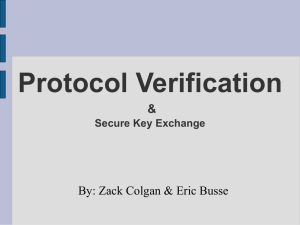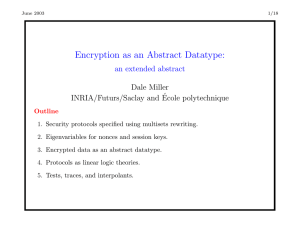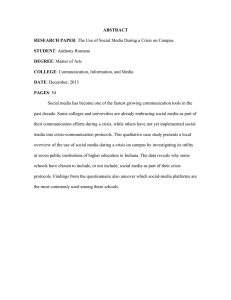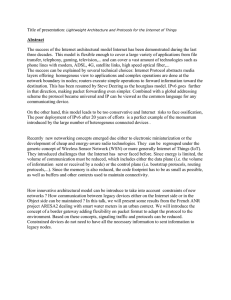Introduction to Computer and Network Security 15-349 Iliano Cervesato
advertisement
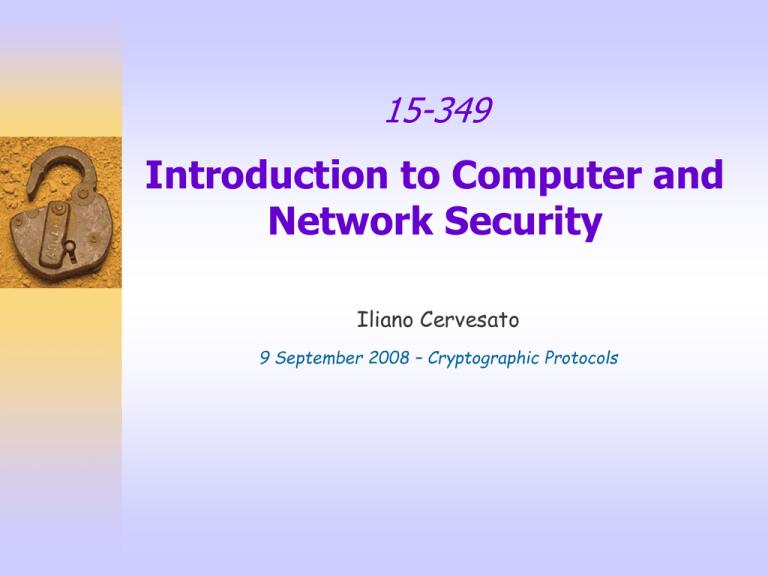
15-349
Introduction to Computer and
Network Security
Iliano Cervesato
9 September 2008 – Cryptographic Protocols
Where we are
Course intro
Cryptography
Intro to crypto
Modern crypto
Symmetric encryption
Asymmetric encryption
Beyond encryption
Cryptographic protocols
Attacking protocols
Program/OS security & trust
Networks security
Beyond technology
2
Outline
“Cryptography is not broken,
it is circumvented”
[Shamir]
What is a protocol?
Authentication protocols
Other cryptographic protocols
Challenge-response exchanges
Key distribution
Shared-key protocols
Needham-Schroeder shared-key
Denning-Sacco
Public-key protocols
Needham-Schroeder public-key
Diffie-Hellman protocol
station-to-station
Repeated authentication protocols
Neuman-Stubblebine
3
Protocols
Expected behaviors when engaging in
communication
When 2 people want to talk
Buying something at the souq
Driving conventions
Calling up your friend, …
When interacting with an organization
Bureaucracy
Official visits by head of states, …
…
When computers want to talk
4
Computer Protocols
What sets them apart?
No human involved!
Automated
Inflexible
No common-sense
What protocols are there in a computer?
Hundreds!
Communication protocols
Email, http, Ethernet, …
Security protocols
5
Security Protocols
Communication protocols ensure that
communication actually happens
Security protocols ensure that
communication is not abused
Protect
Protect
Protect
Protect
contents
communicating parties
intent of communication
possibility of communication
6
Common Security Goals
Confidentiality
Message cannot be observed in transit
Achieved using some form of encryption
7
Authentication
Ensure that we
are talking with
who we think
Much more subtle
than secrecy
How to establish a
secret channel in the first place
Negotiate parameters of channel
Ensure channel remains trusted
Authentication protocols
8
Other Security Goals
Non-Repudiation
Party cannot claim he didn’t do it
For auditing, electronic contract signing, …
Non-Malleability
Message cannot be changed en route
For electronic voting, …
Anonymity
Hide who is communicating
Availability
User can always get through
…
9
Security Protocols
E
D
Encryption provides virtual trusted channels
Security protocols
How to establish, maintain and use these channels
Authentication protocols
How to establish channel in the first place
– Negotiate parameters of channel
– Ensure that channel is still trusted
This lecture
Other types of protocols
Using trusted channels for specific purposes
– Electronic commerce (e-cash, e-auctions, …)
– Electronic voting
– Electronic contract signing, …
10
Authentication Protocols
Challenge-response
Verify somebody is at the other end of channel
Key generation
Establish channel
Key distribution
Bind channel ends with requesters
Key translation
Use indirect channels
These aspects can be combined
11
Some Notation
We abstract from the cryptographic algorithms used
Encryption: {m}k
In particular shared-key encryption
Public-key encryption sometimes written {{m}}k
Authentication: [m]k
In particular for MACs
Digital signatures sometimes written [[m]]k
Usually includes both message and digest
Decryption/verification not modeled explicitly
12
Our Heros
Generic principals
A (Alice)
Servers
B (Bob)
S (Sam)
C (Charlie), …
… specialized names
Attacker
I (intruder)
Also known as
Trusted-Third Party – TTP
Certification Authority –CA
Key Distribution Center – KDC
…
E (Eve – eavesdropper, enemy)
M (Mallory – malicious)
Trudy, ….
13
Challenge-Response Protocols
Given trusted channel
A checks if B is there
Sends challenge to B
Waits for response
A
B
“Hi, it’s me!”
“I’m here too!”
Get B to use the channel
By decrypting the challenge
By encrypting the response
… or both
Used to
Test a newly established channel
Verify a previously used channel
Usually part of bigger protocols
Also called authentication test
A’s view
14
Guarantying Freshness
Reusing challenges is dangerous
Waste subsequent transmissions
Replay of favorable messages
If channel used to transmit keys
and a previous key k was compromised,
then I can force A to reuse k
Response should be fresh
Nonces
Timestamps
Sequence numbers
Fresh key (with care!)
15
Nonces
nA
Random sequence of bits
Typically 32-128 bit long
Generated fresh by originator
as challenge
{nA}kAB
A
nA
Not checked by recipient
Never reused
But may contribute to keys
E.g. by hashing
B
{nA}kAB
Unpredictable
Checked in response
Impractical to memorize them
B
A
B
{nA}kAB
Challenge-response exchanges using nonces
A
{nA-1}kAB
16
Timestamps
tA
Current time in local computer
E.g. in milliseconds
Checkable by recipient
{tA}kAB
A
Allow for clock skew
Use secure synchronized clocks
Supports for service time-out
B
{tA}kAB
Element of predictability
Recipient must keep most recent
timestamps to avoid replay
Requires common time reference
B
tA
A
B
{tA}kAB
{tA-1}kAB
Challenge-response exchanges using timestamps
A
17
Sequence Numbers
cA
Originator maintains counter
Incremented by 1 after each
challenge
Must be bound with data that
identifies channel
B
{cA}kAB
A
B
{cA}kAB
Recipient memorizes most
cA
recent value
Rejects values that are too old
Similar to timestamp but
Local to originator or even channel
Cannot be used for timeout
A
B
{cA}kAB
{cA-1}kAB
Challenge-response exchanges using counters
A
18
A
B
{k}kAB
Initiator generates key k
{“Hi!”}k
Sends it encrypted
Recipient responds using k
Other mechanisms needed to
guaranty freshness to recipient
Often done through third-party
{k}kAS
A
S
{k}kBS
{“Hi!”}k
Achieves key distribution at the same time
B
Challenge-response exchanges using keys
Keys
19
More on Keys
Long-term keys
Exist before the protocol begins
Do not change across protocol executions
Session keys (or short-term keys)
Generated as part of the protocol
Validity guaranteed till protocol is completed
Could be released when protocol terminates
Could be cryptographically weak
Session (or run)
Protocol execution from start to finish
20
Authentication
Assurance to be talking with the expected principal
Challenge-response is a fundamental mechanism
Ensure freshness
If channel is trusted, authenticates
recipient to initiator
Mutual authentication
Both party believe they are talking
to each other
Done through double
challenge-response
Typically 3 messages
A
{A,nA}kB
B
{nA,nB}kA
{nB}kB
Needham-Schroeder
public-key protocol
(fragment)
21
Key Generation Protocols …
A wants to establish channel with B
Shared-key infrastructure
Principals shares a key with a KDC
Public-key infrastructure
Principals have published encryption keys
Diffie-Hellman
Principals know group and generator
22
… with Shared-Key Infrastructure
A
Each principal has a
shared key with KDC S
Ask S to create channel
…
kAS
…
S
kDS
kBS
kCS
D
Create new key k
Distribute k to A and B using kAS and kBS
B
C
Examples
Needham-Schroeder shared-key protocol
Otway-Rees, Yahalom, Woo-Lam, …
23
Needham-Shroeder Shared Key
A
S
B
A,B,nA
{nA,B,kAB,{kAB,A}kBS}kAS
{kAB,A}kBS
{nB}kAB
{nB-1}kAB
S creates kAB
1 challenge-response authenticates S to A
2 challenge-response authenticate A and B
24
… with Public-Key Infrastructure
A
Each principal has a
certified public key
available to others
Public data
kA, kB, kC, kD
…
A and B use kB and kA to
communicate securely
B
CA
D
C
Examples
Bilateral key exchange protocol
…
25
Bilateral Key Exchange Protocol
A
B
A,{nA,B}kB
Public
data
kA, kB
{h(nA),nB,B,k}kA
{h(nB)}k
h is a hash function
Certificates could be included
Includes 2 challenge-response exchanges
26
… with Diffie-Hellman
Diffie Hellman alone cannot guarantee
authentication
Minimum infrastructure required
Public key infrastructure for signatures
Examples
Station-to-station protocol
Found as option in many big protocols
IPSEC, ISAKMP, …
27
Diffie-Hellman Key Exchange
Public data
A
p, g
B
• Choose random a
1 a p-1
• send
ga mod
p
• Receive gb mod p
• (gb)a = gab mod p
• k = h(gab)
ga mod p
gb mod
p
• Receive ga mod p
• Choose random b
1 b p-1
• Send gb mod p
• (ga)b = gab mod p
• k = h(gab)
A and B produce a shared secret out of nothing
However, no authentication
A has no way to be sure 2nd message is from B
B has no way to be sure 1st message is from A
28
Station-to-Station Protocol
A
B
ga
k=
gab
Public
data
p, g
k = gab
k’A, k’B
ga,{[ga,gb]k’B}k
{[ga,gb]k’A}k
This is an authenticated Diffie-Hellman
k’A and k’B are public signature keys
Certificates could also be included
ga and gb used for challenge-response
Achieves mutual authentication
29
Key Distribution Protocols
A and B possess public keys
Registered with certification authority
Certificates not available
Request signed certificates from CA
Examples
Needham-Schroeder public-key protocol
S acts as key database and CA
A and B use nonces for mutual authentication
…
30
Needham-Shroeder Public Key
A
S
B
A,B
Public
data
kA, kB
[B,kB]k’S
{A,nA}kB
B,A
[A,kA]k’S
{nA,nB}kA
{nB}kB
31
Key Translation Protocols
A wants to send message to B
… but no server is around to create keys
A exploits existing channels with a trusted third
party S
A send m to S encrypted with kAS
S forwards m to B encrypted with kBS
Timestamps or other mechanisms used for
authentication
S must be trusted to manipulate them correctly
Examples
Wide-Mouthed Frog protocol
32
Wide-Mouthed Frog Protocol
A
S
B
A,{tA,B,kAB}kAS
{tS,A,kAB}kBS
A generates the key kAB
S provides trusted timestamping
With tA, A authenticates to S
With tS, S authenticates to B
A authenticates to B indirectly
No authentication in the reverse direction
33
Subprotocols
Useful to add structure to protocols
Deterministic choice of continuation
Protocol behaves differently on different inputs
Protocols responds to optional requests
Non-deterministic continuation
Protocol flips a coin
Protocol can request optional behavior
Repeated parts
Repetitive behavior after initial phase
E.g. Neuman-Stubblebine, Kerberos, …
34
Neuman-Subblebine – Initial Part
A
B
S
A,nA
B,{A,nA,tB}kBS ,nB
{B,nA,kAB,tB}kAS ,{A,kAB,tB}kBS ,nB
{A,kAB,tB}kBS,{nB}kAB
{A,kAB,tB}k is A’s ticket to access B’s
BS
service
nA and nB mutually authenticate A and B
35
Neuman-Stubbl. – Repeated Part
A
B
{A,kAB,tB}kBS,n’A
n’B,{n’A}kAB
{n’B}kAB
A uses ticket to access B’s service
… until it expires
n’A and n’B reauthenticate A and B
36
